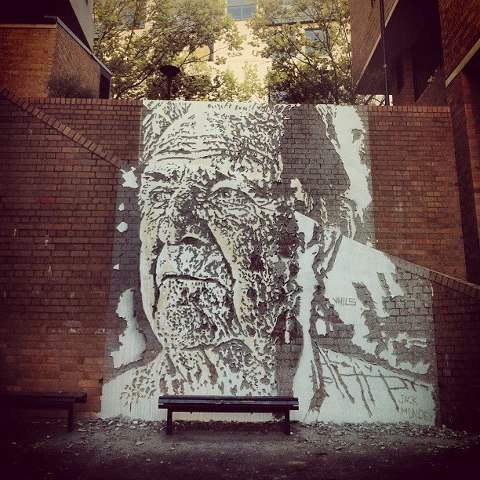Vhils: Dissolve
Chipped, scraped and hammered art about deterioration painted in decay.
Overview
Portuguese-born graffiti/street artist Alexandre Farto, aka Vhils, has taken over The Rocks with his latest exhibition Dissolve; a commentary on the deterioration of human individuality due to globalisation and excessive urban development.
Stripped back and brutally bare, the 25 year old presents a series of large-scale portraits of everyday civilians. Printed on brick walls and wooden doors, he has chipped, scraped and hammered into each one, presenting literal and metaphoric scars on the identity of these people due to the changing nature of urban societies. The rubble that sits at the bottom of each hard-surfaced work symbolic of the irreversible wounds globalisation has bestowed upon the people and their culture.
Other soft-surfaced portraits sit amongst the private indoor collection. Faces have come to life via cut out advertisement posters and magazines, distorted and layered. Shredded, gaping holes allow the viewer to see beneath the surface of the face and into the material influences and elements that have helped recreate the identities of the civilians depicted in these works.
There is also an unfinished tone, a voice that clarifies we are in the very midst of change and that there is still room for further damage. This ties in perfectly with the current cultural controversy in Berlin (where the artist is now based), where it was recently decided to destroy parts of the East Side Gallery to make way for ‘luxury apartments’ and more roads. It is an immensely popular cultural and art icon, and that's not mentioning the Berlin Wall's historical significance during the cold war.
But what makes Dissolve unique to Australian audiences is the inclusion of environmental activist Jack Mundey, whose face is publically plastered on a nearby brick wall. Mundey campaigned to protect the built and natural environment of Sydney from excessive and inappropriate development and has become a powerful icon. The mural is broken into two parts along the wall's surface (separated by stairs). And, just like the portraits of the everyday civilians, his face has been chipped into and harshly effected by the changes in urban culture. The use of the public city as the prime material has also brought forward the crux of Vhils' concept – the relationship between the viewer and his/her environment.
Each portrait ironically mirrors those faces portrayed in Shepard Fairey’s posters (most notably Obama’s Hope poster). Each now appropriated and mass produced, further augmenting Vhils’ issue with consumerism and the indulgence of mass culture, fuelling the path to a unified global identity and a superficial, shallow society.





